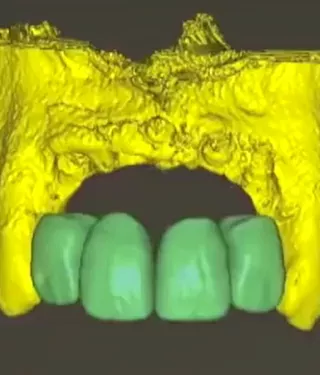
Dental implant treatment planning for esthetic results: Video
In this presentation, Dr. Franceso Mintrone takes us through a clinical case showing the importance of esthetically driven dental implant treatment planning.
A prosthodontist and former dental technician, Dr. Francesco Mintrone is an international lecturer who maintains a private practice in cosmetic dentistry. In this presentation, he takes us through a clinical case to show the importance of esthetically driven dental implant treatment planning. This includes highlighting the benefits of following a digital workflow at every step. He is joined on stage by the implant surgeon of this case, Dr. Sascha Jovanovic; Founder and Academic Chairman of the gIDE Institute and Assistant Professor at Loma Linda University.
Dental implant treatment planning for esthetic results: Clinical case summary
Dr. Mintrone presents the clinical situation of a female patient suffering unsuccessful implant treatment in the esthetic zone. The priority of the patient is to regain her esthetics, and he highlights that while she may appear to have a low smile line, this is not the case – as he has seen with many patients, she is instead shy about revealing her teeth. Dr. Mintrone considers that the patient’s subpar dental esthetics are a result of previous poor dental implant treatment planning regarding a number of anterior implants. Positioned too deep and too buccal, the implants need to be removed, and the soft tissue left to heal. The patient displays a considerable bone defect, and esthetic analysis indicates that bone volume needs to be added through guided bone regeneration (GBR) to achieve an optimal prosthetic profile.
Treatment considerations
Dr. Mintrone explains that with digital scanning and the treatment planning capabilities of DTX Studio™ suite software, it is possible to identify the key factors required prior to surgery. With the end result in mind, the very starting point is to establish the ideal central incisal edge, after which the necessary added bone volume can then be identified. The patient needs to be healthy enough to undergo such a significant augmentation, but the surgeon also needs to have the material, tools and skills necessary to conduct GBR with confidence.
Guided bone regeneration
The material for the GBR procedure used here is a mixture of autologous bone from cortical bone surface shavings and a non-resorbable bovine xenograft. A non-resorbable membrane is put in place to stabilize the graft site. Resorbable collagen membranes are placed in the lateral areas to ensure an effective barrier is in place. Dr. Jovanovic cautions that dentists must be patient at this stage – he and Dr. Mintrone waited nine months after surgery for the grafted site to heal.
The re-treatment process
Nobel Biocare’s On1™ Base is used, preserving the connective tissue structure and providing stability, and narrow platform NobelParallel® Conical Connection implants are placed. Dr. Mintrone shows how the patient now displays a medium smile line with some natural-looking soft tissue even visible. He emphasizes that proper treatment planning at all stages is crucial to achieve results like this in patients that require a high level of tissue regeneration; the prosthodontist, surgeon and dental technician need to all be on the same page.
More to explore
– Discover DTX Studio™ suite: Connecting treatments from beginning to end